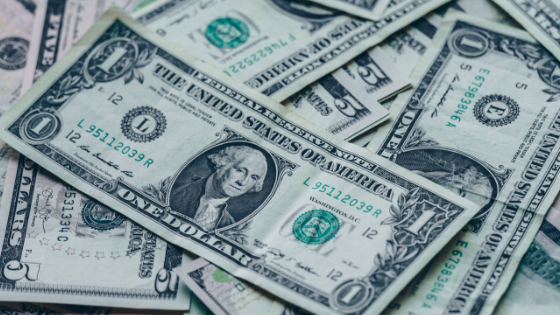Excerpt: “If the Fed cuts rates, the dollar will weaken off, but the issues around the world will offset that. The problem of the strong dollar doesn’t just go away.”
(Bloomberg) — The dollar has been ascendant in 2019 and forecasts for a U.S. recession are growing louder. If the greenback’s strength keeps up and the economy does shrink, some experts are worried this combination will make it harder for the economy to claw back out.
[Vivien Lu Chen | August 28, 2019 | Bloomberg]
A Federal Reserve Bank of New York indicator shows more than 30% odds of a downturn in the next 12 months. Exports and investments are critical parts of U.S. gross domestic product, so a dollar that climbs as rates fall — and traders expect the Fed to keep reducing them — would leave just consumers and fiscal policy to power growth.
Not only does the U.S. currency’s climb tend to erode the profits of American multinationals, but it also raises the costs of foreign corporations with trillions of dollar-denominated debt. The pressure from greenback strength on other economies could even encourage those countries to join a U.S. attempt to weaken it.
“If you start to see the U.S. economy really begin to decelerate and the dollar continue to strengthen, that would suggest a dislocation with fundamentals that is unsustainable and will get the attention of policy makers,” Bank of America senior foreign-exchange strategist Ben Randol said in a phone interview. “If the U.S. can make its concerns heard with its international counterparts, it can potentially get some support for a coordinated intervention that suppresses the strength of the dollar.”
It will take two more months to see which one of two historical patterns will play out, Randol says. The first is that the dollar weakens, as it did ahead of the 1990-91 and 2007-09 recessions. Or the upward move could continue, as it mostly did before, during and after the 2001 downturn.
Because the country is beating other major developed economies in two key ways — greater economic growth and higher bond yields — international money is flowing into the dollar even amid the escalating U.S.-China trade war and the Fed’s July 31 rate cut.
The dollar, which has gained against all but three Group-of-10 peers this year, is having its best decade on record, based on one long-term gauge of the currency’s performance dating back to the late 1960s; a Bloomberg index has jumped 33% since bottoming out just before the U.S. lost its AAA rating from S&P in 2011.
The dollar’s strength over the past year underscores weakness elsewhere in the world and “certainly leaves me feeling uneasy,” said Andy Sierocinski, a foreign-exchange analyst at Klarity FX, a consulting firm that advises corporations on currency risks. “If the Fed cuts rates, the dollar will weaken off, but the issues around the world will offset that. The problem of the strong dollar doesn’t just go away.”
The greenback strengthened against all its G-10 peers Wednesday, with U.S. President Donald Trump’s apparent de-escalation of trade tensions at the Group-of-Seven meeting helping to ease investors’ nerves.
For Christopher J. Wolfe, chief investment officer of First Republic Private Wealth Management, “the interest-rate differential with other countries is the key to why the dollar is remaining strong.” He added: “The U.S. dollar is the easy and clear choice as a deposit safe haven.”
None of the factors that would ordinarily be needed for the dollar to begin a weakening trend are in place, such as rising rates overseas and a narrower growth and yield differential between the U.S. and other countries, according to Randol. Now it may require “a rare combination of more U.S. economic pain and benign financial markets” to set off that process, he said.
While the market narrative on the dollar so far has been focused on the prospects of a currency war, the story line may end up being centered on a coordinated intervention similar to 2000, when central banks joined forces to support the euro, the strategist said.
“To be effective, intervention has to be coordinated by global central banks and finance ministries,” Randol said. “The U.S. can’t expect to achieve a weaker dollar alone.”
(Updates with latest pricing in 9th paragraph.)
Read the original article here.













